| dc.contributor.author | Juric, Radmila | |
| dc.contributor.author | Moholth, Karoline | |
| dc.date.accessioned | 2022-08-10T12:12:42Z | |
| dc.date.available | 2022-08-10T12:12:42Z | |
| dc.date.created | 2022-01-30T19:54:58Z | |
| dc.date.issued | 2021 | |
| dc.identifier.citation | Juric, R., & McClenaghan, K. M. (2021, 15. desember). Including pervasiveness and ubiquity into the HE curriculum: Experience from the USN [Conference presentation]. Proceedings of the Society for Design and Process Science: Transformative Research and Education through Transdisciplinary Means. Workshop on Smart Pervasive Computing, SDPS 2021. | en_US |
| dc.identifier.issn | 1090-9389 | |
| dc.identifier.uri | https://hdl.handle.net/11250/3011122 | |
| dc.description.abstract | Pervasive and ubiquitous environments, where the boundary between physical items and software artifacts are disappearing, have had a significant impact on education, because it is a double edge sward. Pervasiveness is interwoven in software tools and cyber physical spaces in which student learn and teachers disseminate knowledge, in collaborative and experiential manner. At the same time pervasive environments are computational spaces, created and managed by software. They should be a part of any HE curriculum as a teaching topic because they are not very different to any other software products. This paper looks at the possibilities of incorporating into 10 credit modules of the BSc program in Computer Engineering the understanding, characteristics, and evaluation of various examples of software ubiquity through explorative learning and a modest level of tutor intervention. The results confirmed that facilitating students learning by nourishing their individual interest in a variety of topics, which belong to pervasive computing, is the way forward and should be explored further. | en_US |
| dc.language.iso | eng | en_US |
| dc.relation.uri | https://www.sdpsnet.org/sdps/documents/sdps-2021/SDPS%202021%20Proceedings.pdf | |
| dc.title | Including pervasiveness and ubiquity into the HE curriculum: Experience from the USN | en_US |
| dc.type | Journal article | en_US |
| dc.type | Peer reviewed | en_US |
| dc.description.version | publishedVersion | en_US |
| dc.rights.holder | © 2021 Society for Design and Process Science. | en_US |
| dc.source.pagenumber | 19-22 | en_US |
| dc.source.journal | Society for Design and Process Science | en_US |
| dc.identifier.cristin | 1993869 | |
| cristin.ispublished | false | |
| cristin.fulltext | preprint | |
| cristin.qualitycode | 1 | |
